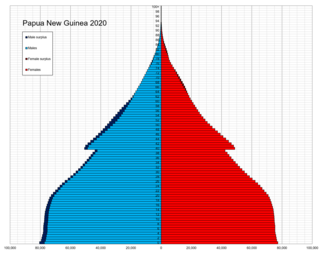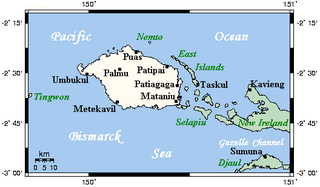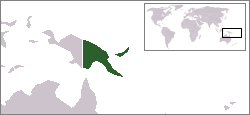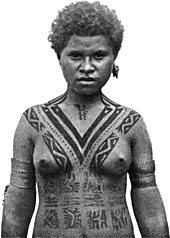
The indigenous population of Papua New Guinea is one of the most heterogeneous in the world. Papua New Guinea has several thousand separate communities, most with only a few hundred people. Divided by language, customs, and tradition, some of these communities have engaged in endemic warfare with their neighbors for centuries. It is the second most populous nation in Oceania, with a total population estimated variously as being between 9.5 and 10.1 million inhabitants.

Port Moresby, also referred to as Pom City or simply Moresby, is the capital and largest city of Papua New Guinea. It is one of the largest cities in the southwestern Pacific outside of Australia and New Zealand. It is located on the shores of the Gulf of Papua, on the south-western coast of the Papuan Peninsula of the island of New Guinea. The city emerged as a trade centre in the second half of the 19th century. During World War II, it was a prime objective for conquest by the Imperial Japanese forces during 1942–43 as a staging point and air base to cut off Australia from Southeast Asia and the Americas.

Melanesia is a subregion of Oceania in the southwestern Pacific Ocean. It extends from New Guinea in the west to the Fiji Islands in the east, and includes the Arafura Sea.

New Hanover Island,, also called Lavongai, is a large volcanic island in the New Ireland Province of Papua New Guinea. This region is part of the Bismarck Archipelago and lies at 2.5°S 150.25°E. Measuring some 460 square miles (1,200 km2), it had a population of 5,000 in 1960, which increased to approximately 17,160 by 2000.

Melanesians are the predominant and indigenous inhabitants of Melanesia, in an area stretching from New Guinea to the Fiji Islands. Most speak one of the many languages of the Austronesian language family or one of the many unrelated families of Papuan languages. There are several creoles of the region, such as Tok Pisin, Hiri Motu, Solomon Islands Pijin, Bislama, and Papuan Malay.
Hiri Motu, also known as Police Motu, Pidgin Motu, or just Hiri, is a language of Papua New Guinea, which is spoken in surrounding areas of Port Moresby.

Central Province is a province in Papua New Guinea located on the southern coast of the country. It has a population of 237,016 people and is 29,998 square kilometres (11,582 sq mi) in size. The seat of government of Central Province, which is located within the National Capital District outside the province, is the Port Moresby suburb of Konedobu. On 9 October 2007, the Central Province government announced plans to build a new provincial capital city at Bautama, which lies within Central Province near Port Moresby, although there has been little progress in constructing it.
In linguistics, Melanesian is an obsolete term referring to the Austronesian languages of Melanesia: that is, the Oceanic, Eastern Malayo-Polynesian, or Central–Eastern Malayo-Polynesian languages apart from Polynesian and Micronesian. A typical classification of the Austronesian languages ca. 1970 would divide them into something like the following branches:
Motu is a Central Papuan Tip language that is spoken by the Motuans, an indigenous ethnic group of Papua New Guinea. It is commonly used today in the region, particularly around the capital, Port Moresby.

Religion in Papua New Guinea is dominated by various branches of Christianity, with traditional animism and ancestor worship often occurring less openly as another layer underneath or more openly side by side with Christianity. The Catholic Church has a plurality of the population. The courts, government, and general society uphold a constitutional right to freedom of speech, thought, and beliefs. A secular state, there is no state religion in the country, although the government openly partners with several Christian groups to provide services, and churches participate in local government bodies.

Melanesian mythology refers to the folklore, myths, and religions of Melanesia, a region in Southwest Oceania that encompasses the archipelagos of New Guinea, the Torres Strait Islands, Solomon Islands, Vanuatu, New Caledonia and Fiji. The various mythologies consist primarily of the traditions of oral literature in the different populations of Melanesia. More recent aspects include the cargo cults born in the 20th century during the Pacific War.

Meke, in the Fijian language, is all traditional style of dance. It is a cognate of the words "maka" (Rotuman) and "mele" in Hawaiian. It is typically performed during celebrations and festivals. Traditionally the dances that comprise the meke art form are performed by groups of men only or women only, however, foreign influences, such as the male/female Tongan ma'ulu'ulu becoming the Fijian vakamalolo, are evident throughout.

Papua New Guinea, a sovereign state in Oceania, is the most linguistically diverse country in the world. According to Ethnologue, there are 840 living languages spoken in the country. In 2006, Papua New Guinea Prime Minister Sir Michael Somare stated that "Papua New Guinea has 832 living languages ."

Lesbian, gay, bisexual, and transgender (LGBT) persons in Papua New Guinea face legal challenges not experienced by non-LGBT residents. Male same-sex sexual activity is illegal, punishable by up to 14 years' imprisonment, but the law is not enforced.

Hiri is the name for the traditional trade voyages that formed an important part of the culture of the Motu people of Papua New Guinea.

The following outline is provided as an overview of and topical guide to Papua New Guinea:

Ela Beach, formerly known as Era Kone, meaning 'Turtle Beach' in the Motuan dialect of the Papuan region of Papua New Guinea, is Port Moresby's primary public beach.
Vabukori is a Motu Koitabu coastal village located in the Moresby South electorate of Port Moresby, the capital city of Papua New Guinea. Vabukori is one of the villages in Central Province that speaks traditional Motu language along with other villages like Hanuabada and Porebada.
Dadi Toka Jr is a Papua New Guinean businessman and the Chairman of the Motu Koita Assembly, a traditional landowner representative group established as an Assembly by an act of the Parliament of Papua New Guinea. The Chairman of the Motu Koita Assembly is also Deputy Governor of National Capital District, which was established on the lands of the Motu and Koitabu people.
Tom Dutton was an Australian linguist specialising in Papuan languages and other languages of Papua New Guinea.














